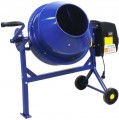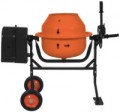Gear ring material
The material from which the
crown is made. It matters not so much in terms of the quality of concrete mixing, but in terms of the durability of the equipment.
—
Cast iron. The most common metal in the manufacture of the crown. Easily processed, quickly cast, characterized by minimal investment at all stages of production. Another notable feature of cast iron is its long service life. At the same time, under mechanical stress, the cast-iron crown can crack, and all kinds of abrasive particles crumble rubbing places. In operation, the crown of cast iron often rattles and vibrates.
—
Steel. High-strength crown material. Steel is more expensive than cast iron, which is more than offset by silent operation. Steel rim cement mixers are great for many hours of daily use.
—
Polyamide. The manufacturing technology of polyamide crowns is based on a synthetic composition endowed with elasticity and resistance to temperatures in a wide range. Rims made from this composite material are notable for their durability, lightweight design, smooth running and quiet operation. The polyamide crown can be partially changed — usually it consists of four parts and one worthless one can be easily replaced.
Finished mixture capacity
The largest volume of mortar that can be prepared in a cement mixer at a time. Since the mixing process according to the most common gravity technology (see "Mixing type") involves an inclined position of the drum, it cannot be filled to the brim — the contents will simply pour out. Accordingly, the volume of the finished mixture anyway will be less than the total volume. The latter is also true for forced-type aggregates.
When evaluating a model with gravity mixing by the volume of the finished mixture, it must be taken into account that due to the shape of the drum, this volume cannot exceed 2/3 of the total capacity — for example, for a cement mixer with a drum of 120 liters, it will be about 80 liters. If the manufacturer indicates higher figures, then it is likely that we are talking about the theoretical amount of concrete that the engine and drive can twist in the drum without problems. This is a good indicator of reliability, but it is far from a fact that just such an amount of solution at a time can be prepared in fact.
Anyway, this parameter also plays the role of a limiter: you cannot load the cement mixer in excess of the volume of the finished mixture claimed by the manufacturer. Yes, it is likely that such a quantity of ingredients will fit in the drum, the device will not break immediately and even be able to work stably for some time. However, the mechanisms of the cement mixer in this mode will experience increased loads, which can lead t...o their premature failure; and such cases are not covered by the manufacturer's warranty.

